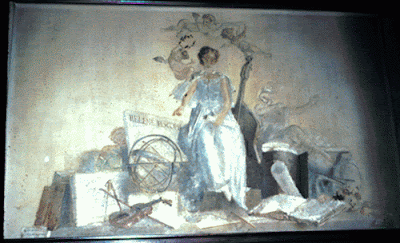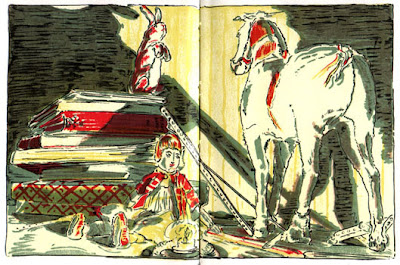So what does it take for a woman to earn something men have earned, even if she can run circles around said men? Money? Connections? Opportunity? Those seem to be the keywords. For instance…..
The University of Padua, Università degli Studi di Padova, founded in 1222, has a long and illustrious history. It has a stellar list of past professors and alumni – Copernicus, Galileo, Reginald (Cardinal) Pole, Nicolas of Cusa, Sir Francis Walsingham, and Giacomo Casanova among many others. It was one of the earliest universities in the world, and became one of the most prominent ones in early modern Europe. It has the oldest original botanical garden, and the oldest surviving permanent anatomical theater in Europe.
 |
University of Padua's Palazzo del Bo.
1654 woodcut image courtesy of Wikipedia. |
Men were awarded Doctor of Theology and Doctor of Philosophy degrees there since its inception. In 1678, Elena Lucrezia Cornaro Piscopia, a Venetian noblewoman and mathematician, became the first woman in the world to earn a Doctor of Philosophy degree. She had wanted a Doctor of Theology degree, but no, it was decided that women couldn’t do that. The Roman Catholic Church did not deem that was proper. They banned females from becoming priests, and granting a woman a Doctor of Theology degree was too close for comfort. (Catholic universities did not allow women to obtain degrees in theology until the 20th century, and in the United States some schools would not allow women to pursue a PhD until the latter part of the 20th century.)
 |
| Image of Piscopia courtesy of Wikipedia Commons. |
However, there were apparently enough members of the University that were upset by this that they met and decided to allow her the PhD degree. This was remarkable because even though it was known that she was attending classes there, the general assumption was never that she would get a degree. Most likely thoughts changed after a philosophy debate held in 1677 in which she participated, arguing in Greek and Latin with three highly respected scholars in front of the entire university, many citizens of Venice, and other scholars from all over the continent.
Lady Elena was born in 1646 into the noble Venetian House of Cornaro. Famous for the commissions of palaces, chapels, villas, theaters, paintings, church art, and much more over the years, the Cornaro family traced its ancestry back to noble Roman roots, including general Scipio Africanus and several consuls of Rome. The family also boasted of having four Venetian Doges, a queen of Cyprus, three popes, and nine cardinals. They were involved in the expansion of the city-state of Venice into the eastern Mediterranean areas. It was in an erudite atmosphere of learning, study, and awareness of the family history that she grew up. It is telling that we know of her, but not of her two elder brothers, or elder and younger sisters, who assumedly had the same advantages, but perhaps not the same abilities.
She began her studies early, beginning at age seven with the study of Latin and Greek. After mastering these languages she went on to study Hebrew, French, Spanish, Arabic, and Chaldaic (biblical Aramaic). Her fluency in these languages made her “Oraculum Septilingue”, a title meaning she was a master, or oracle, of seven languages besides her native Italian. She also excelled in philosophy and theology, which she started learning at a young age as well. Various teachers taught her grammar, dialectics, astronomy, mathematics, and science.
 |
The Great Window in the Memorial Library
Building at Vassar College, showing the
doctoral examination of Piscopia. |
She was also taught what were considered the more feminine arts of singing, reading and writing music, and how to play the harpsichord, clavichord, harp, and violin. At age seventeen, she was considered to be an expert musician, and had earned a reputation as a composer. By the time she was 19, she was considered the most educated woman in Italy, attracting some of the many learned people in Europe to the family palaces in Venice and Padua to meet and talk with her. She learned to debate and excelled at it, which would serve her well in the future.
 |
Detail of Vassar window. Installed in 1906, it was the gift of Mary Clark
Thompson in memory of her husband, Frederick Ferris Thompson. |
She took a vow of chastity when she was eleven, and seemingly kept it all her life. She wanted to become a Benedictine nun, but her father refused to let her, pushing toward further studies, and clearing the path for her to attend the University of Padua. There she flourished, and continued to attract visitors and wage debates, which became famous events throughout academic Europe.
 |
| Detail of the Vassar window showing Piscopia. |
Lady Elena’s doctoral examination was held on June 25, 1678, in the Cathedral of the Blessed Virgin in Padua, rather than at the University Hall due to the size of her audience, and was attended by the University administrators, professors of all disciplines, students, Venetian Senators, and invited guests from the universities of Rome, Naples, Bologna, and Perugia. She spoke for an hour in Latin from selected passages of Aristotle, and answered all questions eloquently. This event became legendary, and she was awarded her PhD, a laurel wreath was placed on her head (the Poet’s Laurel Crown), a ring placed on her finger (the Doctor’s ring), and an ermine cape (the Teacher’s Mozetta) placed on her shoulders. This was an extraordinary event for the 32-year-old woman and the University. It was many centuries before the University awarded a PhD to a woman again.
 |
Detail of Vassar window showing scholars
attendant at her examination. |
She was appointed that same year as a mathematics professor at the University of Padua, another big first, and lectured there until her death. She also lectured on theology and music. After her graduation, she did become a Benedictine Oblate, and spent the last years of her life tending to the sick and poor. She died in 1684 of tuberculosis and was buried in the Church of Santa Giustina in Padua. Her funeral was attended by the faculty in gowns and capes, and her casket carried by four of the professors. She was buried in the habit of an Oblate, with her mozetta over it, wearing a wreath of lilies and laurels signifying her purity and learning. In 1895 the Abbess of the Benedictine nuns in Rome had her tomb opened, her remains placed in a new casket, and a tablet inscribed in her memory.
 |
Detail of Vassar Window. The images in the
tracery (only four of eight shown in this photo)
represent Grammar, Dialectics, Music, Philosophy,
Astronomy, Medicine, Geometry, and Theology. |
A statue was placed in the University, and in 1685 the University struck a medal in her honor, something they had never done before. Her writings were published in 1688, which included both academic and devotional works (not much has survived, however). Upon receiving her doctorate, she was the recipient of praises, poems, and letters of congratulation from scholars all over Europe. Her name was inscribed on the Roll of Honor of many academic institutions in Europe.
 |
| Statue of Piscopia in the Palazzo del Bo, University of Padua. |
An extraordinary woman who led an extraordinary life, Elena Lucrezia Cornaro Piscopia became not only a remarkable woman scholar, but a remarkable scholar of either gender, creating a gold standard not easily equaled, much less surpassed. By anyone. Period.
*******************************






































